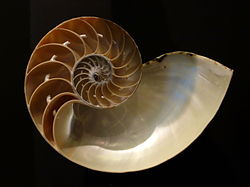Nautiloid
Nautiloids are a large and varied group of marine cephalopods (Mollusca) in the subclass Nautiloidea. They began in the later Cambrian. Nautilus is the only surviving genus.
| Nautiloids Temporal range: Late Cambrian – Recent
| |
|---|---|

| |
| Nautilus pompilius | |
| Scientific classification | |
| Unrecognized taxon (fix): | Nautiloidea |
| Orders | |
|
Palcephalopoda
Neocephalopoda (in part) | |
Nautiloids flourished during the early Palaeozoic era, when they were the main predatory animals. They developed an extraordinary range of shell shapes and forms. Some 2,500 species of fossil nautiloids are known, though only a few species survive today.[1]
Taxonomic relationships
Nautiloids are among the group of animals known as cephalopods. The cephalopods are an advanced class of molluscs. The cephalopods also include ammonoids, Belemnites and modern coleoids such as octopus and squid.
Traditionally, the most common classification of the cephalopods has been a three-fold division into the nautiloids, ammonoids, and coleoids. This article is about nautiloids in that broad sense, sometimes called Nautiloidea sensu lato.
Cladistically speaking, nautiloids are a paraphyletic group united by shared primitive (basal) features not found in derived cephalopods. In other words, they are a evolutionary grade that is thought to have given rise to both ammonoids and coleoids. They are defined by the exclusion of both those descendent groups. Both ammonoids and coleoids probably descended from bactritids, which in turn arose from straight-shelled orthocerid nautiloids.[1]
The ammonoids (a group which includes the ammonites and the goniatites) are extinct cousins of the nautiloids which evolved early in the Devonian, some 400 million years ago.
Nautiloid Media
A cross-section of a Nautilus pompilius shell, showing the large body chamber, shrinking camerae, concave septa, and septal necks (partial siphuncle supports)
Fossil nautiloid Trilacinoceras from the Ordovician of China.
Fossil orthoconic nautiloid from the Ordovician of Kentucky; an internal mold showing siphuncle and half-filled camerae, both encrusted.
Cross-section of an Orthoceras nautiloid from the Siluro-Devonian of Erfoud, Morocco.
Reconstruction of Cyrtoceras sp
Gyronaedyceras eryx, an oncocerid from the Middle Devonian of Wisconsin
Acleistoceras whitfieldi, an oncocerid from the Middle Devonian of Wisconsin
Trocholites, an tarphycerid from the Upper Ordovician of Wisconsin








